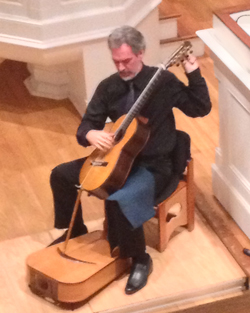by Nicholas Stevens

Galbraith’s fine shadings of tone and timbre stole the show in this solo concert at Plymouth Church on Saturday, March 17, presented under the auspices of the Cleveland Classical Guitar Society.
At the start of the Allemande from Bach’s French Suite in c, the minor-mode melody floated along as though buoyed by an icy breeze. Galbraith differentiated between “contrapuntal” voices early on, with melodies ringing out only to be answered by echoes with completely different tone qualities. The Courante swayed gently. Omitting the Sarabande, Galbraith moved into an Air that reached resolution in a languorously splayed-out final chord. The Menuet had a melancholic grace, and the Gigue bristled with punchy, almost stifled notes.
The advantages of that extra bass string became clear in Galbraith’s arrangement of Scriabin’s Op. 11, No. 17, the warm opening of a suite fashioned from his miniature keyboard Preludes. String harmonics enriched Op. 2, No. 2, and the variance in timbre that Galbraith displayed all evening distinguished Op. 16, No. 4. Closing out the set, Op. 11, No. 21 had the comforting luminescence of a meadow at sunset.
Three selections by Isaac Albéniz followed. Galbraith flew through the opening of Torre Bermeja with no apparent effort, and as with all of the Albéniz pieces, the return of the initial melody after a divergent middle section elicited a thrill of recognition. Galbraith’s rendition of Mallorca was the highlight of the evening, with the nocturnal, haunting bassline of the first tune returning despite the heavenly glow surrounding the contrasting middle melody. Even the dark patch in Sevilla had a certain honeyed tone, the outer portions a sun-soaked dance.
Galbraith reserved his most substantial set for the latter half of the program. By transposing Haydn’s keyboard Sonata in c-sharp minor (Hob. 16, No. 36) up to e minor, and juxtaposing its three movements with the finale of Haydn’s Sonata in E major (Hob. 16, No. 31), Galbraith created a grand-scale symphonic form. Bold rhythmic decisions added substantial interest to this part of the program, in which Haydn’s keyboard music proved less persuasive as raw material for guitar transcription than that of Bach or Scriabin.
Called back for an encore, Galbraith played Robert Schumann’s “Mignon” from Album for the Young. This simple piano piece sounded wonderful, with Galbraith plucking the bass notes at the center point of the low strings, where they ring the clearest. Allowing the melody to rush and recede, Galbraith demonstrated that, irrespective of the instrument, technique and attention to detail remain essential characteristics of the true artist.
Photo: Erik Mann.
Published on ClevelandClassical.com March 21, 2018.
Click here for a printable copy of this article



